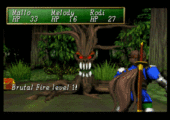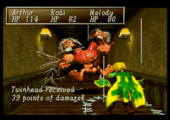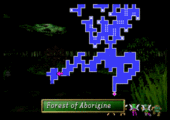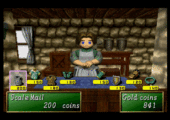Genre: RPG Developer: Sonic! Software Planning Publisher: Sega Enterprises Players: 1 Released: 1996
In my four plus decades as a Sega fan, I’ve seen the evolution of the company’s game design and all the various improvements to many of its franchises. With each new anticipated installment, one could see the progression as new concepts and mechanics were implemented. It was great to see brands like Shinobi and Phantasy Star grow and be more fleshed out with time.
One brand that’s always been near and dear to me is the Shining series. Let me clarify that. I’m referring to the original series of inter-connected games that spanned several releases and gameplay styles across the Genesis, Sega CD, Game Gear, and Saturn. I was extremely excited for the first title, Shining in the Darkness, and its first-person perspective and gorgeous visuals. It didn’t disappoint, and I marveled at the way the Shining Force games all connected back to it even though they didn’t share the same design. Sega created a whole universe, but I wondered if we’d ever see another dungeon crawler within it. My answer came in 1996 with the release of Shining the Holy Ark, a return to form on Sega’s powerful 32-bit Saturn. I pre-ordered it and fell in love instantly (I still have that same copy).
Set a decade before Shining Force III, the story revolves around Arthur, a mercenary who sets out with two companions, the shaman Melody and magician Forte, to capture a ninja named Rodi. Their brief battle inside a mine ends when an escape pod crashes into it, and the resulting collapse practically kills the four of them. Arthur and his companions are revived by mythical spirits that occupied the pod, except that a fourth, malevolent spirit has now possessed Forte. The trio embarks on a quest to save him, and along the way they unravel a dire prophesy about the return of the Thousand-Year Kingdom.
While it maintained the same first-person blueprint of Shining in the Darkness, Sega went in a different visual direction this time, foregoing hand-drawn environments for 3D-rendered locales. The characters were still 2D sprites, albeit with a pre-rendered look, something games like VectorMan and Donkey Kong Country had made popular at the time. The choice mostly worked, giving Shining the Holy Ark a aesthetic much in line with many games of the era. It did a good job of showing off the Saturn’s power, though movement was still tile-based and slow, and the frame rate sometimes struggled to keep up with the action. It was never too much for the system, but you could tell there was a lot going on under the hood. The presentation was rounded out by an excellent score from Motoi Sakuraba, the mind behind just about every Telenet game on the Genesis including Arcus Odyssey and El Viento. Sakuraba-san would later harness his musical talents to create the score for Shining Force III.
Despite the graphical change, the gameplay and turn-based combat was just as smooth and solid as ever. Anyone who’s played the other Shining titles would be able to jump right in here. Shining the Holy Ark shared the same animated menu system that Sonic! Software Planning used in all the other installments. The little moving icons were simple and intuitive and helped convey that sense of continuity from the previous games. I remember smiling the first time I booted up Shining the Holy Ark and saw those menus. It was like a 16-bit friend welcoming me back.
The dungeons were not quite as forgiving as the menus, however. Navigating the many varied locations in the Kingdom of Enrich could be a bit frustrating, as it was with most old school dungeon crawlers. Dead ends, massive labyrinthine dungeons, and a high encounter rate were obstacles that could deter some from seeing the game through to the end. These flaws weren’t exclusive to Sega’s 32-bit RPG, but perhaps some might think that more should have been done to evolve the genre. I will say that there were many more positives about Shining the Holy Ark than negatives, and I was able to get past the encounter rate soon enough. There were multiple characters to swap out in the party, and they had their own personalities and fighting styles. There were some excellent puzzles as well (the one with the gems and statue one will always be burned into my mind). Sonic! Software Planning did make some things easier, such as an auto-map that could be brought up quickly by pressing start. No more using magic to check your location! Swapping out any of the seven party members was also simple. Inactive characters were part of a reserve team accessible through the tactics sub-menu, and all but Arthur could be removed from the active party.
Combat had some unique aspects to it as well. Along with their standard attacks, characters could perform power attacks based on their critical and technique (magic) rating. The higher the ratings, the more frequent the power attacks. These special moves ranged from a deadly strike to healing magic and were often timely morale boosters. Nothing was better than seeing a party member pound an enemy or heal the others in a critical situation.
“Pixies” could also be found throughout the game, and they would join the party to fight. These little helpers were actually composed of several fey folk that included pixies, leprechauns, incubi, succubi, and fairies. Frozen in stasis in all sorts of hidden places, they attacked in groups depending on the direction from which the foes appeared. Pressing the should buttons selected the group, and a timely press of the A or C button at the start of the fight activated them. A large group of these little helpers could inflict serious damage and helped make the battles in later levels move faster.
I found the mix of these gameplay mechanics and the great presentation to make Shining the Holy Ark a refreshing take on the dungeon crawler at the time. These kinds of games weren’t all that prolific on the Genesis, with only Shining in the Darkness and Sword of Vermilion standing out. Both of those games had their own problems (small game window, for instance), and other titles like Might & Magic II proved far too complex and difficult for many console gamers. Shining the Holy Ark tried to make the genre more user-friendly while bringing the Shining franchise to the next generation, and it also tried to appeal to an older audience. Sonic! Software Planning believed that fans of the Shining games had matured by the time the Saturn arrived, and they were ready for a darker entry in the series. The game still has plenty of lighthearted moments, but the overall tone is significantly more sinister than in previous titles.
My conclusion is simple. If you like the Shining games or RPGs in general, then you simply must play Shining the Holy Ark. Despite its shortcomings, it’s a fantastic upgrade to the series that first started on the Genesis in 1991, and still looks and plays great. It’s been more than 25 years since it landed on the Saturn, and we’re long overdue for another entry. Sadly, Sega has virtually discontinued the inter-connected Shining universe, so the chance of seeing a new title is slim. Until then, there’s always the trusty ol’ Saturn to fill that void.
SCORE: 8 out of 10










Recent Comments